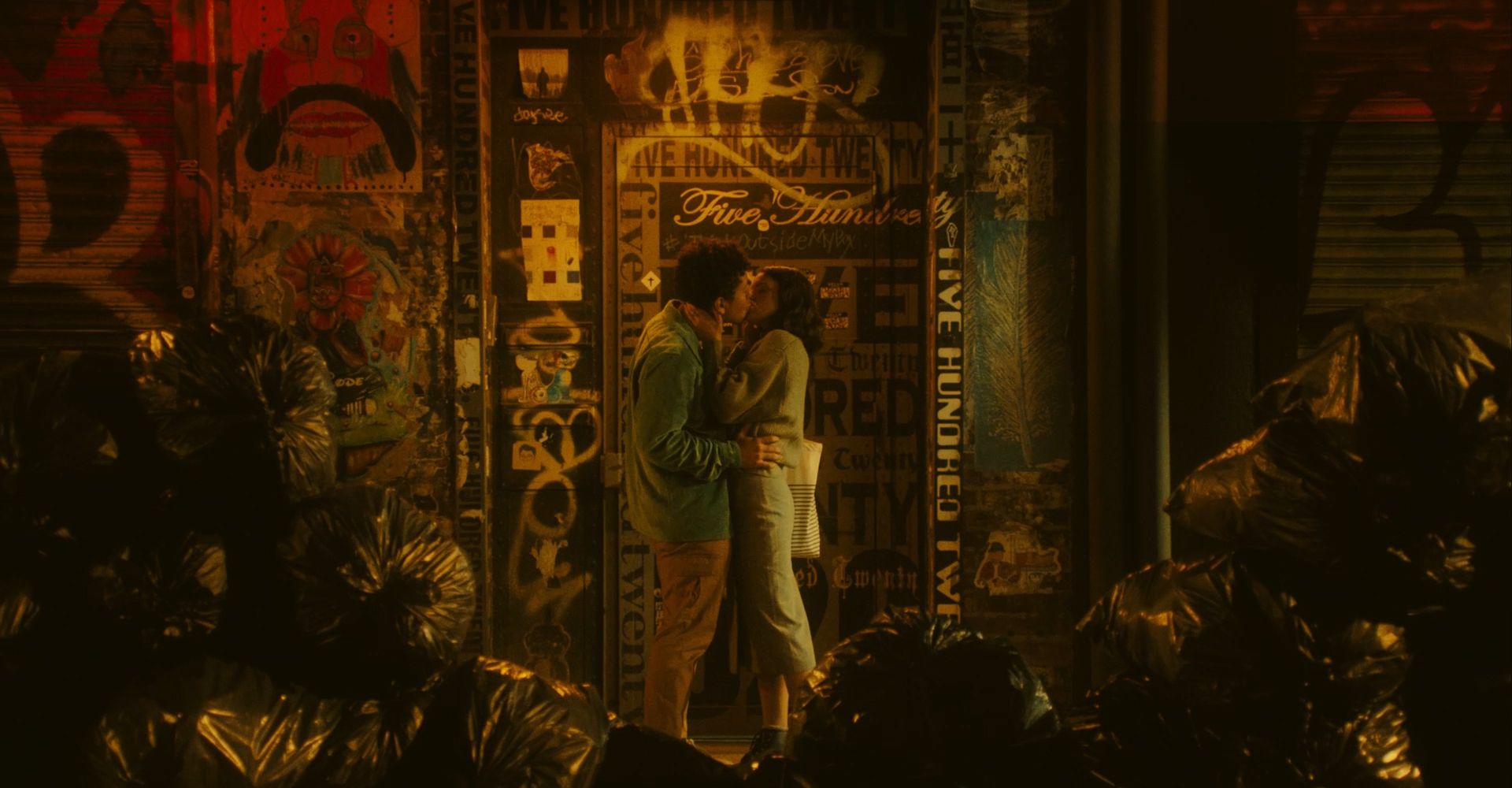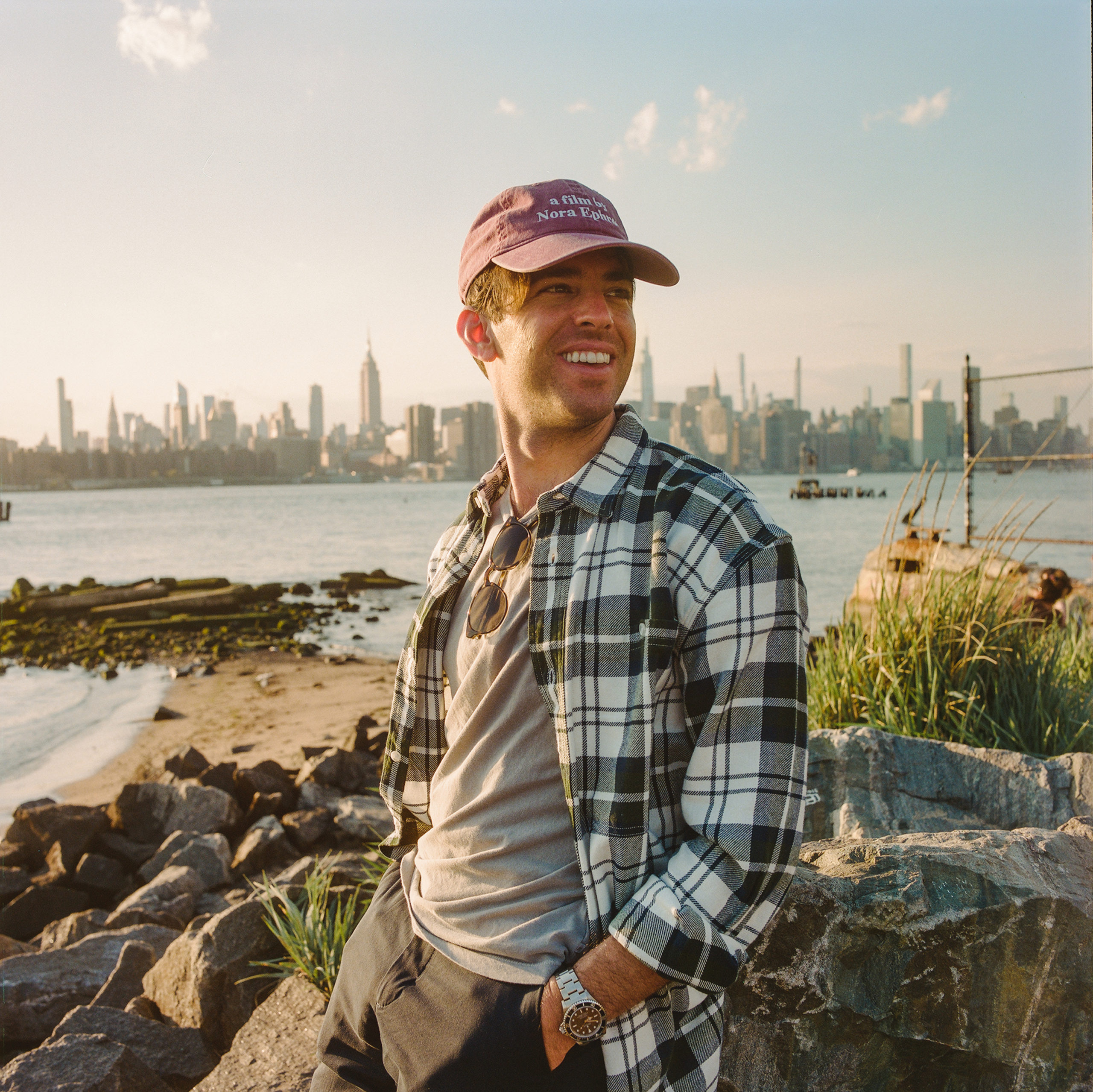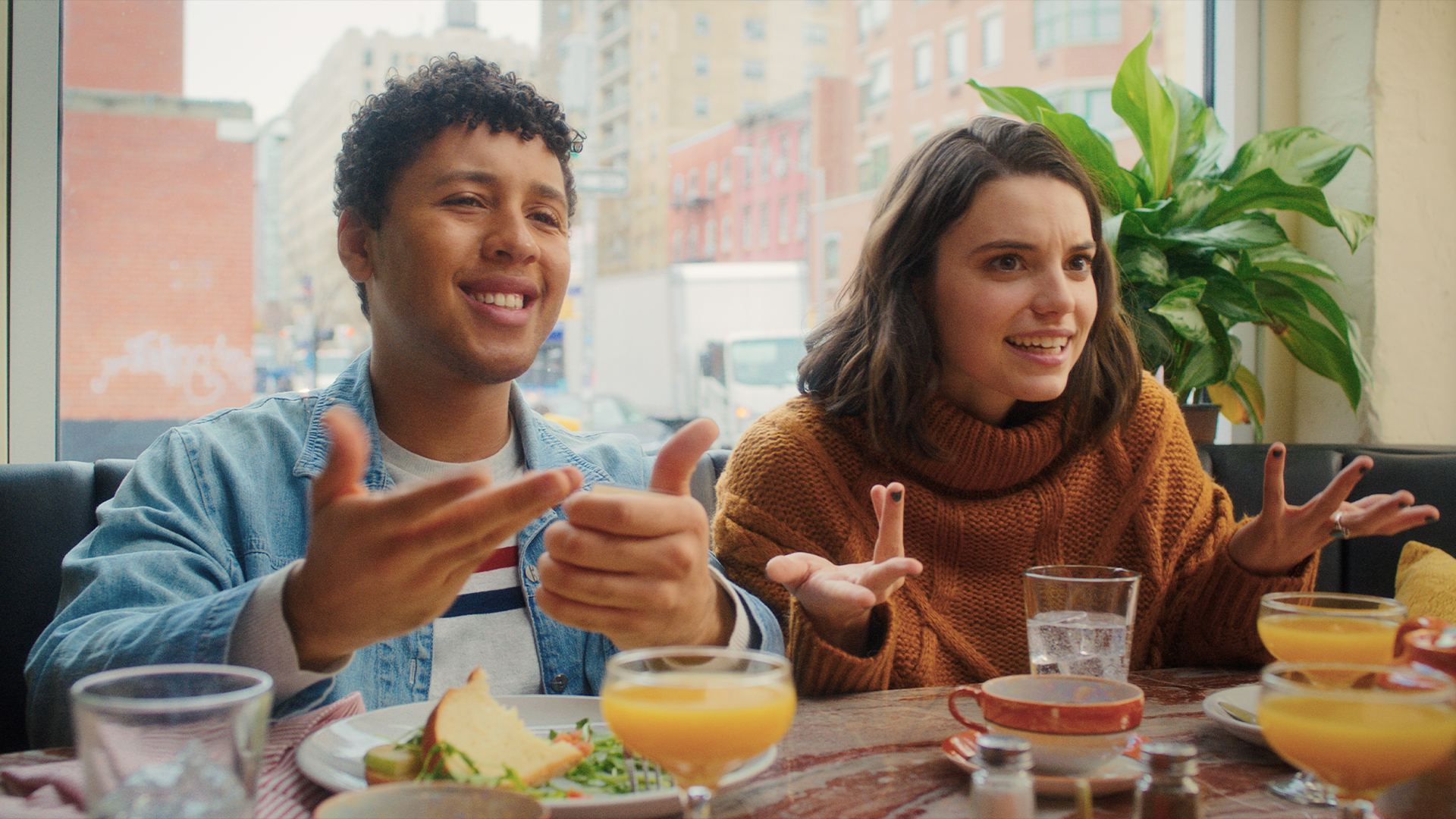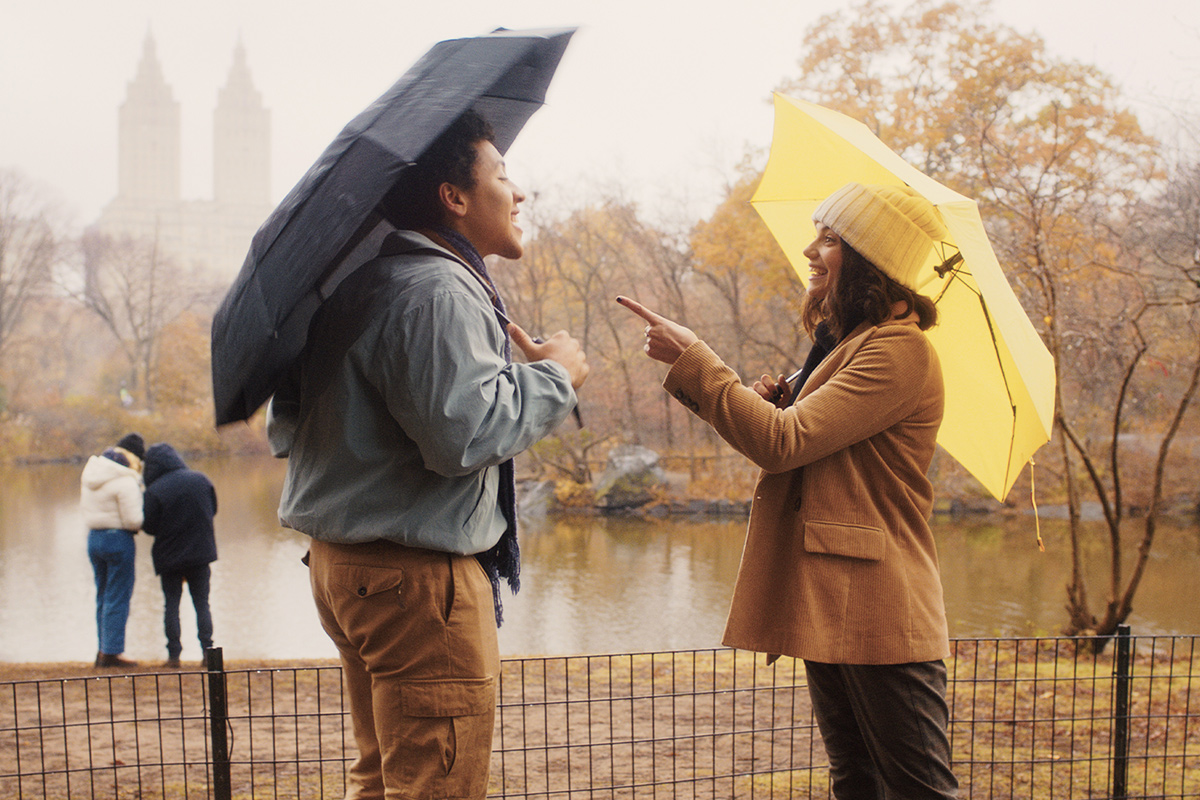“Whenever two people start sleeping together, it gets complicated,” Catherine Cohen’s Jessie Katz tells her friend, Wendy, in the trailer for the new romantic comedy “Dating & New York,” out today. Wendy, played by Francesca Reale, has recently entered into a “friends with benefits” situation with Milo (Jaboukie Young-White) and pretty much everyone around them agrees they’re kidding themselves if they think this situation can end any way except poorly. We watch as Wendy and Milo grow closer together — and then further apart — as they attempt to navigate dating each other when they haven’t quite figured themselves out. Meanwhile, they’re cheered along every step of the way by their mutual friends Jessie Katz (Cohen) and Hank Cadner (Brian Muller).
Written and directed by Jewish native New Yorker Jonah Feingold, the film is an updated take on the whole “can men and women really be friends (with benefits)?” question, filled with all of the nuances of modern dating — from crafting the perfect text to becoming Instagram official.
In honor of the film’s release, I spoke with Feingold about what makes “Dating & New York” a Jewish rom-com, the impact Jewish culture has had on his craft, and — of course — the Nora Ephron of it all.
Nora Ephron said this thing that was like, “The difference between a Jewish rom-com and a non-Jewish rom-com is that in a Jewish rom-com, it’s internal forces keeping [the couple] apart, and in a non-Jewish rom-com, it’s external forces keeping them apart.” So, would you would consider your film a Jewish rom-com?
By that definition, I think it certainly is a Jewish rom-com, because these two characters… it’s all in their heads and they’re all overthinking everything and overanalyzing. They’re their own worst enemies. That’s the pitch that I gave both those actors, too: Ultimately, it’s your own fault that this relationship doesn’t work. It’s not that you weren’t right for each other. And so they’re always neurotic about the minutia of modern dating, all the way down to, “What should I text this person? Is it weird to double text somebody?” It’s all these fake rules we create for ourselves. And the only external forces — to your point — are just the New Yorkisms. The only real external force between these two characters is that they live too far away from each other. It’s, like, too many subway stops.
What are some of the other New Yorkisms that you would say generally affect dating?
The first one is location. For example, if you live in Brooklyn and you’re going to try to date someone who lives on the Upper West Side, that is a long-distance relationship. I wonder what the rule is, and I’m curious what consensus we might come to — maybe you can travel 45 minutes and that’s it? And then maybe you get bonus chunks of time for such perks as an in-unit washer-dryer, functioning air conditioning, a gym in the building…
I’m obviously joking because if you love someone, you should travel wherever they are. But with New York dating, if you can find someone who lives near you, has an in-unit washer-dryer, and makes you happy, then that’s the one for you.
That’s the dream. In “Dating & New York,” in which ways were you making your characters self-destruct, and how did that feel as you worked on the film?
I’m not necessarily afraid of confrontation, but I do try to avoid conflict at all costs, and the root of these characters’ conflict is that they’re not being truthful to what they want. Wendy’s afraid of having a relationship again because she doesn’t want to go through a breakup ever again. Unless you want to be alone forever — which maybe she does — I think you need to be able to confront that fear. And Milo, on the other hand, is a character who I think we can all relate to, who falls in love very quickly and says, “Oh my God, this person’s the one,” and becomes obsessed with them and fantasizes this idea of them, but ultimately, she’s not that person. At the same time he’s still drunk-texting his neighbor that he used to hook up with. So pick what side you’re on: Do you really love this person or are you just sort of seeking attention?
I do feel like we live in an attention economy, where we need it so much, especially after this last year of being inside. It’s not even about who it’s coming from — just that you’re getting it.
Absolutely. You see a character like Milo who’s super bummed in one scene, but then he goes home and he’s on his couch and he posts a selfie and is getting all these likes, and he’s happy again. Everything is so quick and short and fleeting that you wonder what actually matters. What is real? What do I care about now?
It’s sometimes hard to tell. I feel like everybody I know is in happy, cool relationships or they’re in on-again, off-again hookup situations where no one gets out alive.
That’s exactly what the characters in the movie were supposed to be: Hank and Jessie, two characters who play it by the books who end up together, and Milo and Wendy, who are in this on-again, off-again situation. I would be curious to check in with them and see if they’re still together. Cuffing season’s coming up; I’m sure Milo shot Wendy a text being like, “Hey, we should get drinks sometime.”
I’d love to talk about how you think growing up Jewish in New York City influenced you and influences the movie as well.
Growing up Jewish in New York City, it never stood out that we were part of a minority, basically. When I went to USC for film school, people would say, “Oh, you’re Jewish?” And I’m like, “What do you mean? No one’s ever asked me, what does religion have to do with anything?” I mean, especially on the internet, sometimes you see people in the comments: “Jonah Feingold, is that a Jewish name?” Hold on, guys — what are we doing here? This doesn’t need to be a thing.
Growing up in New York, you are in a very safe place, where there’s a lot of Jewish geography — which I think is a thing, having gone to a sleepaway camp and to, you know, Dr. Lempshen, the orthodontist. I tried to take a little bit of that and put it into the movie. You know, you have run-ins with exes, and Jessie and Hank [two Jewish characters]. In my mind Milo is half-Jewish. There is an element of “we all sort of know each other one way or another,” and that’s what I love about being Jewish in New York —there’s an instant sense of connection and family. Out at a bar, you can say, “I know your friend of a friend and now we’re friends, by the way.” You see that with characters even in the opening scenes, where they’re friendly and meeting each other and it’s an “I feel like I know you” type situation.
Also, Cadner is my mom’s maiden name, which was cool to do, and Jessie Katz is named after this woman I used to know from camp who I haven’t seen in 10 years.

Obviously this is a love letter to New York City, so I’d love to hear a little more about how you chose some of your locations and why they’re important to you.
Well, we were making an indie movie, so what locations could we get for free? A lot of the restaurants you see are friends, like August Laura in the East Village. We did a comedy club scene there, we did a brunch scene there, we did a dinner scene there.
And then you had favors. There’s a ferry scene — I’ve always wanted to shoot on the ferry, I think it’s so visually interesting. I will say it’s nearly impossible to do. You have the noise, the cold, anything on water is always very complicated.
I also put some special places from growing up in New York in the movie. You know, my first kiss was outside Bethesda Fountain, which is in the movie. The characters’ first kiss is at one of our friends’ apartment exteriors that has this great graffiti. It looks like a backlot — which is kind of the effect we were going for.
I think it’s important in a New York movie that you can walk around the city and you can say to yourself, “Oh, this is where they shot that scene.” I’ll never forget the scene from “Elf” when the kid tells Will Ferrell he saw a dog, because in the background of that shot is the lower school I went to. Now, whenever I walk past there, I think of “Elf.”
New York City is a place where you repeat certain locations. “This is where I lost my iPod in 7th grade,” “This is where my first kiss was,” “This is where I got dumped,” “This is where I spilled coffee on my new shoes.”

Did Jewish movies or influences impact your movie?
There’s obviously “Crossing Delancey,” which is a fantastic film that I was introduced to right before production. I was obsessed with the iconography of that movie and the ‘80s aesthetic — and yet those characters have a very modern vibe, way ahead of its time. (Or maybe that was the time? I don’t know.) The Albert Brooks movie “Modern Romance” was an absolutely smash inspiration — like, wait, you can just make a movie that’s about exploring a modern relationship and that can be the movie? And obviously “Seinfeld” was a huge inspiration, which is iconic Jewish Upper West Side energy. The biggest inspiration is Billy Crystal’s performance in “When Harry Met Sally” — and Meg Ryan’s, of course, but I also think Billy Crystal is a little bit of both the characters [in “Dating and New York”]. I don’t know if I see the Wendy character as a Meg Ryan type so much as I see her as an Elaine or a Billy Crystal, someone who’s trying to always resort to humor. And then obviously a strange fairy tale energy that came in from childhood, growing up on ‘90s cartoons.

Do you want to mention some of the “When Harry Met Sally” homages in the film?
I mean… Barry Sonnenfeld, the cinematographer [of “When Harry Met Sally”]… what did he do to make those trees look so fall-y? The second we sat down together, Maria Rusche, my cinematographer — who’s so fantastic — was like, “This is the vibe we’re going for: commercial, ‘90s energy.” The biggest thing we took away from “When Harry Met Sally” is actually the sweater game. Shout out to my costume designer, Hope: Our conversation was, “It’s fall, it’s cozy, it’s comfy, we want sweaters in every single scene.” Someone on Letterboxd wrote, “Take a shot every time you see a comfy sweater,” and I was like, that’s exactly what we were going for. Turtleneck vibe, knit sweater vibe. I think Nora Ephron invented that, and we are so lucky that she did. And we will take that from her.
I did also love that Wendy has a blazer moment — felt very Diane Keaton. I feel like that was intentional.
Iconic blazer moment! I know that I am a Jewish white dude trying to make a movie that appeals to all genders and speaks to a truth about modern relationships. So I’m super proud of the fact that our crew and our department heads were about 80% female. That was important because while I wrote the script, these things need to be fleshed out and understood in ways that I will never understand. When we were talking about anything from dialogue to what are the things the character cares about in the scene, or the way that they might articulate their past, where they went to college or what their major was, all the way to what they would be wearing in the scene. If Jaboukie is going on a first date — is he wearing a sweater? Is she wearing a blazer? Why is she wearing a blazer? Oh, because she maybe didn’t see it as a date so much as a friend hang.
If you get your entire crew on the same creative vision and you’re just able to say, “This is what we’re all going for,” that’s a beautiful thing. You’re all making the piece better and you’re able to elevate the way a scene looks and feels. I think we got super lucky that we were all able to see the exact same vision for the movie.
“Dating & New York” comes out today, September 10, in theaters and on iTunes, Apple TV, Google Play, and other streaming platforms.



